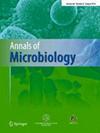Investigation of the location and secretion features of Candida albicans enolase with monoclonal antibodies
IF 3.4
4区 生物学
Q2 BIOTECHNOLOGY & APPLIED MICROBIOLOGY
引用次数: 2
Abstract
The glycolytic enzyme enolase plays important role in the pathogenesis of Candida albicans infection and has been also considered as a promising molecular marker for the diagnosis of invasive candidiasis. This study aimed to investigate the location and secretion features of Candida albicans enolase (CaEno) with a couple of specific monoclonal antibodies (mAbs). Two mAbs named 9H8 and 10H8 against CaEno were generated by fusing SP2/0 myeloma cell with the spleen lymphocytes from CaEno immunized mice. The specificity of the mAbs was then validated by Western blot and liquid chromatography-mass spectrometry (LC–MS/MS). A diverse set of experiments were conducted based on the pair of mAbs which involved immunohistochemical staining analysis, whole cell enzyme-linked immunosorbent assay (ELISA), double antibody sandwich ELISA, and confocal microscopy to analyze the possible location and secretion features of CaEno. CaEno is abundantly expressed in the cytoplasm of C. albicans blastospores and is distributed in a ring-shaped pattern along the cell wall. CaEno appeared in the hyphal C. albicans as just a “mushroom” form. CaEno was found to be weakly expressed on the surface of blastospores but constantly expressed at various stages of growth. CaEno concentrations in C. albicans blastospores culture supernatant are considerably higher than in C. albicans hyphae culture supernatant. The dynamic changes of supernatant CaEno concentration in blastospores and hyphal C. albicans exhibit distinct features, although both appear to be associated with the C. albicans growth state. When cultivated under normal circumstances, however, no apparent CaEno degradation was seen in the cell-free supernatant. Our results implied that CaEno was constantly expressed on the cell surface and its secretion features varied according to the growth stage of C. albicans. However, further experimental and theoretical studies are needed in future to identify the specific mechanisms by which this phenomenon can arise.单克隆抗体研究白色念珠菌烯醇化酶的位置和分泌特征
糖酵解酶烯醇化酶在白色念珠菌感染的发病机制中起着重要作用,也被认为是诊断侵袭性念珠菌病的一个有前途的分子标志物。本研究旨在利用特异性单克隆抗体(mab)研究白色念珠菌烯醇化酶(CaEno)的定位和分泌特征。通过将SP2/0骨髓瘤细胞与CaEno免疫小鼠的脾脏淋巴细胞融合,制备了两种针对CaEno的单抗9H8和10H8。然后通过Western blot和液相色谱-质谱(LC-MS /MS)验证单抗的特异性。采用免疫组化染色、全细胞酶联免疫吸附试验(ELISA)、双抗体夹心ELISA和共聚焦显微镜等方法,对CaEno可能的定位和分泌特征进行了分析。CaEno在白色念珠菌芽孢细胞质中大量表达,并沿细胞壁呈环状分布。CaEno出现在白色念珠菌菌丝中,只是一种“蘑菇”形式。CaEno在胚孢子表面表达较弱,但在不同生长阶段持续表达。白色念珠菌芽孢培养上清液中CaEno浓度显著高于菌丝培养上清液。芽孢和菌丝白色念珠菌的上清CaEno浓度的动态变化表现出不同的特征,尽管两者似乎都与白色念珠菌的生长状态有关。然而,当在正常情况下培养时,在无细胞的上清液中未见明显的CaEno降解。我们的结果表明,CaEno在细胞表面持续表达,其分泌特征随白色念珠菌生长阶段的不同而变化。然而,未来需要进一步的实验和理论研究来确定这种现象产生的具体机制。
本文章由计算机程序翻译,如有差异,请以英文原文为准。
求助全文
约1分钟内获得全文
求助全文
来源期刊

Annals of Microbiology
生物-生物工程与应用微生物
CiteScore
6.40
自引率
0.00%
发文量
41
审稿时长
3.2 months
期刊介绍:
Annals of Microbiology covers these fields of fundamental and applied microbiology:
general, environmental, food, agricultural, industrial, ecology, soil, water, air and biodeterioration.
The journal’s scope does not include medical microbiology or phytopathological microbiology.
Papers reporting work on bacteria, fungi, microalgae, and bacteriophages are welcome.
Annals of Microbiology publishes Review Articles, Original Articles, Short Communications, and Editorials.
Originally founded as Annali Di Microbiologia Ed Enzimologia in 1940, Annals of Microbiology is an official journal of the University of Milan.
 求助内容:
求助内容: 应助结果提醒方式:
应助结果提醒方式:


